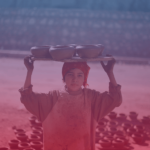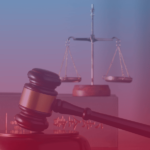
The Cover of Hope
Artist: Kaizer Olya, Bukovinian State Medical University
The main idea of the artwork is connected to the cancer treatment using cord blood cells. I see it as a real hope for those people who seek for the cure of their illness. As far as this kind of treatment is yet to be studied, I imagine this process as knitting. Loop by loop, row by row, slowly and carefully the scientists and medical doctors of the world create a chance for a long and healthy life for future generations.
Cancer and its treatment represent a considerable burden for each country regardless of its political and financial state. The EU conducts a significant research in this branch of medicine. In my country, Ukraine, we often send our patients to continue their treatment of cancer in Germany or Switzerland, for the treatment options there are far progressive and hopeful. We are also aware that considerable investigation in the field of cord blood cells is taking place in south EU countries and especially Greece.

T1N0M0
Artist: Tetiana Antypova, Bukovinian State Medical University
This artwork has an intention to depict lack of clinical manifestation of malignant tumors in mammary glands and female reproductive organs at early stages. Breast cancer is the most common cancer in the WHO Europe region women. Cervical cancer, ovarian cancer and uterine cancer are among the most common cancers in European women.
Particularly, cervical and ovarian cancer in women of Eastern Europe tend to show lower five-year survival rate for treated patients, mainly due to untimely diagnosis of the condition.
Adequate diagnostics of pre-malignant conditions and malignant tumors at early stages is crucial to successful cancer treatment. To aid this purpose, regular screening tests, meticulous monitoring of patients in groups of high risk, and self-examination play a role of utmost importance.

The future in fetal stem cells
Artist: Anna Kravchuk (Sauliak)
The number of cord blood transplants has been increasing very quickly with more than 250 cases reported to Eurocord Registry and more than 500 patients transplanted via the New York Cord Blood Bank. Several cord blood banks worldwide established a group called Netcord whose goal is the standardization of the procedures, the organization of internal audits for accreditation and qualification, and the communication and exchange by internet of donor search on an international basis.
NetCord includes structures such as the EuroCord (based in University Paris Diderot, France), MonaCord (Centre Scientifique de Monaco),Cord Blood center Group (Slovakia, Romania, Hungary, Austria, Italy and Czech Republic), FamiCord Group (the largest European Cord Blood Bank), Vita 34 (one of European cord blood banks) and many other organizations.
In our country there is the Ukrainian Stem Cell Bank (FamiCord), which is currently controlled by Poland partners – FamiCord.
I would like to take part in this activity and support the theme «I Am and I Will», because it is very important to remember who you are for yourself, for society and how can/should you help people, who are not such lucky and healthy, as you are.

Thank you, Parents
Artist: Kateryna Lishchuk, Bukovinian State Medical University
Teratomas are types of tumors, which we can see in children and are formed from precursor cells (stem cells) or part of the blastocysts and develop from three germinal leaves. They are very interesting because of their complex structure and appearance. Usually children have malignant neoplasms of vessels and internal organs, which have connected with teratogenic influences on a mother’s organism. Also, genetic factors and the environment play an important role in their development. Therefore, in my work, parents are viewed on a larger scale than their ancestors. In my opinion, humanity bears responsibility for several flaws in carcinogenesis from environmental pollution to limited access to healthcare.
So, let’s remember: it is our common task, of all scientists, doctors, educators and others to pay attention to this problem, to inform about the daily losses and the risks. Of course, healthy habits don’t guarantee “immunity” against cancer, but if you can reduce the chances of complications in you and your nearest , why not? Why should we play Russian Roulette every day? Healthy youth is the key to the prosperity of any civilization. Let’s protect our home (the most beautiful blue planet) and our body for the sake of humankind. At least have a chance to prove its worth, not just sink into the tones of its own swamp. If this is of interest to all, I believe that by 2030, we will decrease the amount of cancer deaths.

Attempt to rejuvenate
Artist: Tayisiya Krasnova, Bukovinian State Medical University
Some cancers can be treated with stem cells. Cord blood taken from a newborn contains multipotent cells. Such cells have revolutionized the treatment of hematological cancer. Being administered after chemotherapy they can rebuild the hematopoietic system, the ability of the organism to produce blood, from scratch.
At the same time, our understanding of stem cells has provided us with valuable insights concerning cancer cells. We can unravel the ways they become malignant replicating, escaping immunity and eventually forming deadly tumors. Therefore, we can fight them in a more effective way.
Stem cells are a very promising area of research. In the European Union there are several prestigious research centers engaged in this area. Academic and Industrial institutions have invested a great deal of funding and time in them. At the same time stem cells research is supported by the Horizon 2020 EU Framework Programme for Research.

Fighting for hope
Artist: Chariklia Kariniotaki, Medical School – University of Crete, Greece
My inspiration for this painting were the people who suffer from lung cancer, which is the leading cause of cancer deaths, accounting for 1,76 million deaths in 2018, according to WHO. I depicted the lungs as stiff black rocks in a sea of malignant pleural effusion, which is usually a sign of advanced disease. Some stars appear among the dark cloudy thoughts, only to set the suspicion of brain metastases. These thoughts inevitably concern time, which seems to be moving forward, but is actually a countdown to zero. However, there is a doctor there, inside the patient’s soul, pulling the time rope, trying to turn desire for life extension into reality.
Prolonged survival in lung cancer patients is feasible nowadays, thanks to recent advances in understanding the biology of lung cancer, which are resulting in new targeted therapies with very encouraging outcomes. The most important issue, however, is the prevention of lung cancer, in which the “Europe against cancer” programme has played a significant role, by developing strategies to tackle risk factors, such as smoking and occupational exposure to carcinogenic substances, and by developing the “European code against cancer” to educate people on how to reduce their risk of cancer. It has been estimated that almost half of all deaths due to cancer in Europe could be avoided if everyone followed the recommendations.

Allez
Artist: Zhyrulyk Yurii Mykchailovych, Bukovinian State Medical University
Like in fencing, people face numerous and various rivals in everyday life. Sometimes we don’t even know what hides behind the mask: a divorce, work problems or cancer. The most important thing is to hold on during this decisive duel. Moreover, not less essential is accepting yourself in any form. Such policy is widely spread in the EU, so it must turn worldwide for all people to remember: any problem is resolved if the mind is healthy. So, êtes-vous prêt?

Magic rescue
Artist: Hanna Avramenko, Bukovinian State Medical University
Cancer is one of the leading causes of death among children and adolescents worldwide and is annually diagnosed in approximately 300,000 children from birth to 19 years old. Pediatric oncological diseases include many different types of tumors that occur among children and adolescents aged 0-19 years old. The most common categories of childhood oncological diseases include leukemia, malignant brain tumors, lymphomas, and dense tumors such as neuroblastoma and nephroblastoma.
The correct diagnosis is crucial for treating children with cancer because each type of cancer should be treated according to a specific schedule, which may include surgery (as well as stem cell immunotherapy), radiation therapy, and chemotherapy.

 The ’Ndrangheta’s Infiltration and Threat to European Institutions
The ’Ndrangheta’s Infiltration and Threat to European Institutions  From Paper to Practice: How Grassroots Norms Undermine Gender Rights in Pakistan
From Paper to Practice: How Grassroots Norms Undermine Gender Rights in Pakistan  Exploited Childhoods: The Role of Global Corporations in Perpetuating and Mitigating Child Labour
Exploited Childhoods: The Role of Global Corporations in Perpetuating and Mitigating Child Labour  Human Rights Challenges in Addressing SLAPPs in Media, NGOs and Journalism in the EU
Human Rights Challenges in Addressing SLAPPs in Media, NGOs and Journalism in the EU